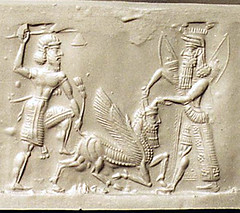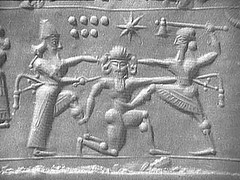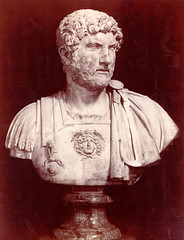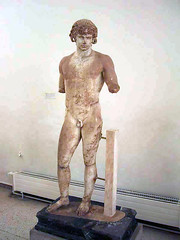SEXUAL INTEREST IN MEN
|
- Sexual interest in men |
|
- Conclusion: Male-male bonds are masculine
|
"If they (macho youth of military/police/mafia) would go make out with each other (and I use that word in its most positive and appreciative sense) the world would be vastly improved. They make it with women only to brag about it, but are actually far happier in the barracks than in boudoirs. We may be destroying ourselves through the repression of male-male bonds.â ~ Alan Watts, Buddhist scholar and author.
In the ancient world, love and sexual intimacy between men was not supposed to be limited to a 'sexual minority', as is made out today. Most men developed such bonds, which were institutionalised and blessed by society. Today we live in an entirely different world ----- one that is the result of a few thousands of years of oppression of such bonds.
Most evidences of these universal love bonds between masculine men in the ancient world have been destroyed through the ages ----- but many have survived ----- from ancient Greece to even more ancient tribes that are still living in New Papa Guinea and the Andaman and Nicobar islands, from the ancient Celt and Germanic warriors of Europe to the medieval Samurai warriors of Japan. To take an example, in ancient Greece, during their youth, men 'married' other young men, marrying women only when after they reached 30 years of age.
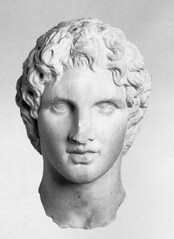 |
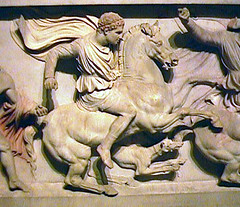 |
|
|
p Alexander the Great (356 - 323 BC) He conquered the world, but was conquered by his lover Hephaestion --- his boyhood friend and second in command. His famous words, "Hephaestion is Alexander" are now immortalised.. |
p Hephaestion (born ca. 356 BC - 324 BC) Hephaestion was even more handsome and a greater warrior than Alexander himself. When Hephaestion died in the war, Alexander adjudged him God. He could not recover from Hephaestion's death, and died of an unaccounted illness within six months. |
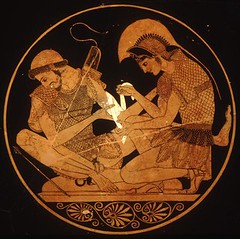 |
t An ancient Greek cup depicting Achilles bandaging Patroklos' arm. Achilles and Patroklos were two great ancient Greek warriors around 7th century bc. When Patroclus died in the war, Achilles revenged his death by killing Hector. Achilles was so devastated after Patroclus' death that he refused to part with his body. He finally relented when he was told that if not cremated Patroclus will go to hell. But he cut a piece of his hair lock to keep with him for the rest of his life. |
All these societies were warrior cultures, and the masculinity of the warriors flowed from their bonds with their male lovers. Lover pairs fought their enemies and defended each other till death, took care of their lover when he fell sick, stood by each other in the thick and thin of life. It created several legends, such as that of Gilgamesh and Enkidu, the two most powerful men in ancient Sumeria, who were first staunch enemies and then became inseparable lovers; Alexander the Great and Hephaistion were one of the greatest conquerors the world has known and also one of the most committed lovers. Hadrian is said to have fought with and killed a lion with his bare hands to save Antonius. In these cultures, love between two men was considered the most masculine and purest form of love.
There is evidence that in ancient tribal societies, men who had the highest honours were especially sought after as lovers by other men, and honour was especially sought for this. Even in later societies, like ancient Greece, young men would participate in deadly wrestling bouts in order to win honour and male lovers.
Deep and committed sexual bonds between male pairs have also been widely reported amongst wild life by researchers, lately, after suppressing such evidences for centuries. From dolphins to elephants, from lions to crabs, from sea creatures to apes. There are several evidences now that it is a universal sexual drive amongst mammals. Indeed most mammalian males prefer to live and bond with other males. This includes one of our closest cousins in the wild, with whom we share most of our genes: the chimpanzees. Bands of fearsome male chimpanzees stick together in everything they do, throughout life. Their bonds are extremely strong because they are also sexual. They hunt together, fight enemy groups together, defend each other from enemies and even help their partners in procreating by helping them to mate with females. It makes life much easier and worthwhile. Such bonds apparently provide an evolutionary edge and many scientists are now challenging Darwinism.
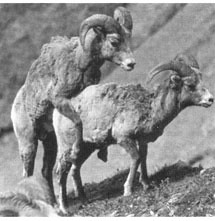 |
t Two rams making love |
Scientists now state that human beings are capable of being sexually attracted towards both men and women. Ironically, while all traditional societies knew and acknowledged this fact, modern heterosexual societies suppress and misrepresent it, claiming that sexual desire for the same sex occurs only in a few.
Men have always secretly known and understood the universal male need for intimacy with men, but have also known that the society strongly discourages open acknowledgement of such desire. They are also aware of a class of antagonistic males amongst them who, though a minority, are very loud. They derive extreme power from the prevalent sexual norms. They oppose/ isolate male-male desire as soon as they see a hint of it, for example, by calling the person a homosexual.
Calling a masculine gendered man a homosexual is one of the severest ways of putting him to shame. It is inappropriate. It suggests that the person is no longer a member of the male pack and strips the man of social honour and masculinity. If not proved otherwise, it can isolate and bar him from his peers and he may not get the opportunity to cultivate and develop his natural masculinity. Since a discussion on this topic is stigmatized there is no way left for a masculine man, but to disown his same-sex feelings.
This vulnerability has prevented the strongest human gender from asserting one of its most basic rights.
|
Bonds between men in traditional India
In Indian society, men have traditionally enjoyed close bonds with each other. These bonds can easily become secretly erotic. Relationships between men have prospered within this male solidarity, albeit secretly. As long as men married and produced a son and fulfilled other social duties, society looked the other way. What would surprise many is that before the British arrived in India, the Indian society had many socially approved spaces in the mainstream male society, where male-male intimacy flourished openly. Most such spaces and customs were destroyed by the long British rule, but some survived till a century ago.
In the traditional society, male social intimacy was not seen as a threat. It was the male-female intimacy that was not tolerated by the society --- unless it was in marriage and in private.
We have seen how the heterosexualisation of Indian society is changing this traditional masculinity pattern. Heterosexualisation also includes the homosexualisation of male-male love. It is one of the most basic forms of male oppression.
Homosexualising male-male love
After destroying the male-only spaces, the forces of heterosexualisation uproot and destroy every trace of male-male bonds from the mainstream. They forcibly drag these relationships out of the social purdah in the security of which they survived for centuries. Masculine gendered men promptly react by disowning their sexual need for men --- as a means of survival. Any remaining instances of masculine male bonds are imposed with 'social femininity', labeled and promptly thrown together with feminine gendered males into a new social category --- 'homosexual'.
The misleading western concept of 'sexual orientation' comes extremely handy in this. As same sex bonds become strongly associated with the 'homosexual' group, mainstream men adopt the misleading 'heterosexual' identity.
Men in India have so far resisted the homosexualisation of male-male intimacy because heterosexualisation of Indian society has not fully taken place and traditional male-only spaces are still strong. Indian men don't think that having sex with another man will make them homosexual. But the countdown has begun and parts of Indian culture, including the media (especially TV which has a strong influence on young people) and parts of Westernised urban India are almost completely heterosexualised. Indian men are increasingly being cornered.
|
Portraying man's desire for men as 'feminine' and 'different'
The more a society artificially keeps male-male sexuality out of the realm of social masculinity, the more men will 'willingly' avoid and disown it. Therefore painting such bonds as 'unmanly' and 'feminine' is a prime stratregy of a heterosexual society.
As part of the homosexualisation process, sexual desire for men is increasingly being propagated in India as a feminine, 'gay' thing, represented by feminine hairdressers and fashion designers. The only depiction of male-male sexual desire is through negative symbols including ugly, funny, weird and queer (feminine) characters.
|
|
The root of the myth that male sexual desire for men is feminine is a related myth that such an interest makes a person desirous of being penetrated. Being penetrated is seen as a 'female' thing. By making a motivated connection, it becomes easy to propagate male-male sexual desire as feminine. Interestingly, masculine male desire for another male seldom involves anal penetration ----- whether active or passive ----- even though some men may experiment with it occasionally. Nevertheless, the truth is that receptive anal sex is not inherently feminine. It is gender neutral. In fact, in several ancient tribal societies it was considered a masculinising factor.
Another related strategy to keep male-male bonds out of the mainstream is to propagate them as 'different', 'minority', 'deviant' or at best 'alternative'. This gives the heterosexual society, which otherwise claims to be open and fair, an excuse to marginalise these bonds. Science is increasingly being abused and manipulated to generate this illusion.
|
|
While such researches have obvious irregularities and gaps, the media nevertheless highlights them for their masala value, and the fact that they strengthen the 'heterosexualisation/ homosexualisation' process.
One drawback of these motivated researches is that while they use feminine gendered males as their sample, their results are portrayed to include all male sexual desire for men ----- since the western definition of 'homosexuality' does not distinguish between feminine and masculine gendered men. But the basic drawback is that they conveniently assume that the modern socio-political 'gay' identity constitute a distinct biological group, which is an absurd and unscientific assumption. Men of different genders came together on a common platform 'homosexual' in the west only because of their oppression under heterosexualisation and not because of any biological affinity. Thus science too becomes a tool of man's oppression.
Overall, the scientific community has tried to study sexuality in a very haphazard and abstract way. Thus they are bound to arrive at wrong (often motivated) conclusions. Like the proverbial four blind men who tried to find out what an elephant is. They touched one small part of the elephant and described the whole elephant accordingly as being like a rope, a pillar, a snake or a fan. There have been few sincere and honest attempts at studying human gender sexuality in its entirety.
Difference between 'homosexuality' and 'masculine male bonds'
Terms like 'sexual orientation', 'heterosexual' and 'homosexual' distort and misrepresent the truth about male gender and sexuality. The basic assumptions behind these terms are wrong. Sexual orientation is not a valid concept.
When these western/ heterosexual terms are forced upon a traditional society like India, the meaning and connotation of these change. E.g. the sexual identity 'homosexual' becomes a gender identity.
Since a 'homosexual' identity of sorts has already been created in India, it becomes important to be able to distinguish between sexual bonds between mainstream men and what is termed as 'homosexuality'. This requires re-defining the word 'homosexual' and 'homosexuality' --- and bringing them closer to reality.
The table below enlists the main differences between what has come to be known as 'homosexuality' and what in this book, we are calling 'masculine male bonds':
|
Difference |
Homosexuality |
Masculine male (sexual) bonds |
|
1.Gender |
Feminine gendered: Homosexuality refers to the sexual desire of a feminine gendered male for another male. |
Masculine gendered: The sexual desire of a masculine gendered male for another male does not need a separate terminology. |
|
2.Social identity |
A Homosexual thus is a feminine gendered male who desires other males. |
No separate identity or description is required to describe a masculine gendered man who desires another man, as it is a near universal male quality. |
|
3.Feeling different |
Most homosexuals describe feeling different from other boys, even before they discover their sexuality. This difference is primarily because of their feminine gender but is wrongly associated with a sexual desire for men. Homosexual men look for a separate identity from masculine men. |
Masculine gendered men who are in touch with their same-sex feelings do not feel 'different' from other men, and they do not like to be segregated into a separate social category. |
|
4.Nature of sexual bonds with men |
Tend to prefer multiple partners. |
Tend to bond one to one. |
|
5.Preference of partners |
Tend to prefer feminine gendered males. |
Tend to prefer masculine gendered males. |
|
5.Attitudes of women |
Women are largely supportive of 'homosexuals'. |
Masculine male bonds threaten the 'invisible power' of women. Many women are therefore antagonistic towards such bonds. |
Note: In a heterosexualised environment homosexuality also refers to the weakened, emasculated, powerless and purposeless masculine bonds which remain after they are persecuted in the mainstream.
Conclusion: male-male bonds are masculine
In spite of the intense propaganda and oppression, there is nothing inherently feminine or deviant about male sexual desire for men. A masculine man's sexual desire for another is nothing but masculine. Male-male intimate bonds (outside the 'gay' space) still have the capacity to take men to the height of positive masculinity.
In fact, an important reason for banning male intimate bonds from the human civilisation is that it strengthens and cultivates the natural masculinity of men. Civilisations have long been struggling to discard male masculinity and they cannot cope with heightened masculinity which is celebrated so openly. Societies do not know how to manage this raw power. Unless it is channelised properly, it may get out of hand and threaten the 'civilised' society, particularly the marriage institution. The civilised society does not want to guide and cultivate masculinity. So it finds the easy way out by 'banning' it. A case study of how they tame animals will make this phenomenon easier to understand.
Case study
A Horseman who ferries pilgrims to the Kedarnath shrine in Uttaranchal has narrated how they train male and female horses to become couples, and how they prevent male horses from bonding with other male horses.
The male horses have a natural and spontaneous bonding instinct with other male horses. If two male horses develop intimacy it is extremely difficult to separate them. Such horses are also extremely difficult to make docile. A horse will not care about his life and fight fiercely if, say, someone beats up his partner. For this reason male bonds are considered a menace, and horses forced/ trained to bond with females. They prevent male horses from developing intimacy â and never put them together.
Fortunately, there are examples in history and in the present societies that have successfully encouraged and channelised masculine bonds without jeopardising the marriage institution. The ancient Greeks are the best example.
